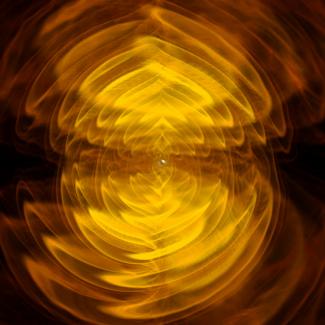The merger of supermassive black holes is a hot topic in astrophysics. Such mergers may occur after the formation of black hole binaries during galaxy collisions. The mergers are predicted to emit gravitational waves, whose detection is the mission of the Laser Interferometer Space Antenna (LISA). In preparation for the LISA mission, which is scheduled for launch in 2035, Fellow Peter Bender is working with colleagues around the world to improve LISA’s design (see JILA Light & Matter, Summer 2006).
In the meantime, Fellow Phil Armitage wants to know whether black-hole mergers could also emit light (of any wavelength in the electromagnetic spectrum). If black-hole mergers do emit light just before or right after the black holes coalesce, then other space observatories might be able to scan for the mergers, too. Alternatively, if light emission due to mergers occurs, but is weak, other space observatories could focus their telescopes on newly coalesced black holes once they have been identified by LISA.
New simulations have recently given scientists a better understanding of the circumstances that could lead to emission of light during a black hole merger. The simulations were performed by former research associate Elena Rossi (now at the Hebrew University in Jerusalem), Armitage, and their colleagues at the Università degli Studi di Milano, the University of Leicester, and the UK’s Institute of Astronomy.
The simulations modeled the dissipation of both kinetic and potential energy in gas surrounding a merged black hole after it has recoiled in response to the emission of gravitational waves. In this work, the researchers assumed that a newborn supermassive black hole is surrounded by a thin disk of gas. Their simulations suggest that previous estimates of the efficiency of energy release were orders of magnitude too low. Paradoxically, however, the predicted luminosity from disks around massive recoiling black holes appears to be far smaller than previously thought.
Here’s why: According to the simulations, the amount of light that would be emitted by "low-mass" merging black holes (with masses equal to 1 million suns) would be large only if three conditions were satisfied: (1) if the recoil velocity caused by the emission of gravitational waves during the merger is at least 1000 km/s; (2) if the recoil, or kick, occurs close to the plane of the disk of gas surrounding the merging black hole, and (3) if the surrounding disk’s mass is large enough.
The third condition is the problem. The interaction of the disk with merging black holes probably does generate either X-rays or infrared light. But, at the large distances from the black hole where most of the light is emitted, a massive disk would likely fragment into stars that are almost unaffected by the merger. And a low-mass disk doesn’t add enough light to the total to create a flare that would be noticeable among the stars and galaxies.
The result is that merging black holes likely emit only relatively low-luminosity light. This "dim" light probably cannot be identified in a wide-area sky survey. However, once a merger has been detected by LISA, other observatories should still be able to obtain valuable information by conducting follow-up studies of the light streaming out of the merger site. - Julie Phillips




